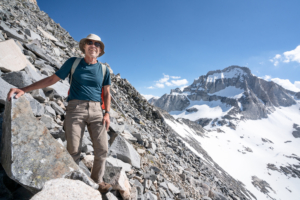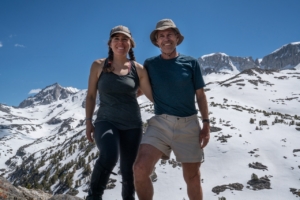There Are More Mountains to Climb
“When I read about the Castle Crags project, I decided that this was an organization I should support.”
-Wayne Pfeiffer
Wayne Pfeiffer spent his childhood in Wichita, Kansas, a land of gentle rolling plains and an elevation of about 1,300 feet. His only climbing options as a child were the large trees behind his house, which he tackled with gusto at every opportunity. In eighth grade his perception of the great, flat outdoors expanded when a young history teacher came to his school from California and described its rugged, mountainous wilderness as “God’s country.”

Wayne Pfeiffer descending Pyramid Peak with Bear Creek Spire behind him in California’s Sierra Nevada. Photo credit: Betsy Pfeiffer
“I remember thinking that’s where I’m going when I get out of school,” says Wayne. “I studied hard, graduated from college, and was accepted to graduate school at the California Institute of Technology. I was eager to leave Kansas and explore the outdoors, so I went to Pasadena in the summer of 1965 before the start of the fall quarter. There I met other students who wanted to do cool things outdoors like climb mountains, which we didn’t have in Kansas,” says Wayne.
That summer, Wayne and his new friends climbed Mounts San Gorgonio, Whitney, and San Antonio. Over the next 20 years, he climbed about 50 peaks, including the dozen 14,000-foot peaks in the Sierra Nevada of California and the highest peaks in Washington, Wyoming, and Mexico.
What draws Wayne to the wilderness? “First of all, there is so much natural beauty to observe and appreciate. In addition, you have to be self-reliant. When you are on a five-day loop and no one else is around, you have to think about what you’re doing and be prepared.”
Wayne took a break from climbing after having two children, Betsy and Gordon. “Going away on mountaineering trips wasn’t popular in my house when the kids were young,” says Wayne. “But as soon as Betsy was old enough, she came with me and we resumed climbing. She’s been my climbing partner for the last 20 years.”

Wayne and his daughter Betsy hiking in the Sierra Nevada. Behind them is Bear Creek Spire on the left and Mounts Abbot and Mills on the right.
Photo credit: Betsy Pfeiffer
A few years ago, Wayne read an article about The Wilderness Land Trust’s Lundy Canyon acquisition in Eastern Sierra. In 2019 the Trust purchased this 49-acre former mining claim within the Inyo National Forest. It is adjacent to a popular hiking trail into the upper entrance of Lundy Canyon and had been identified as a high priority for protection from private development in order to conserve Mill Creek, safeguard wildlife habitat and ensure recreational access for the public. Wayne was familiar with the area because he and Betsy had climbed Matterhorn Peak and Mount Dana, to the north and south of the canyon, respectively.
“After reading about the Lundy Canyon project, I went to the Trust’s website and learned they were acquiring inholdings throughout the west, including in the Castle Crags Wilderness.” In 2018, The Trust purchased 1,257 acres of land adjacent to the Castle Crags Wilderness, providing additional public recreation access, including access to challenging granite climbing with great views of Mount Shasta. And in 2019, the Trust purchased the 637-acre Little Castle Lake property, which straddles the wilderness boundary and includes a portion of Castle Lake and all of Little Castle Lake. Both properties have been transferred to the United States Forest Service for permanent protection.
“Betsy and I had admired the rocky terrain of Castle Crags from a previous trip to climb Mt. Shasta, and when I read about the Castle Crags project, I decided that this was an organization I should support,” adds Wayne.
Until recently, Wayne and his late wife Mary took vacations cycling in the mountains of the western U.S. and Canada, Europe, Costa Rica, and Chile, while still working as a scientist and engineer. Now he looks forward to spending more time in the mountains with Betsy. “She’s a better climber than I am on serious rock walls. However, she still likes to climb mountains with me where we’re a good match. Plus, there are more mountains to climb.”
You can read more about Wayne’s work and adventures at his website: waynepfeiffer.com.


